We tested the device, reviewing these features and more to see whether it's worth purchasing despite the expensive price.
We compare the quality of the images and videos captured by the Go Pro Hero 7 with those taken on an iPhone and an earlier Go Pro Model, the Hero 5, to assess whether it's worth paying the additional cost or whether, in fact, another device can offer a similar quality for a lower cost.
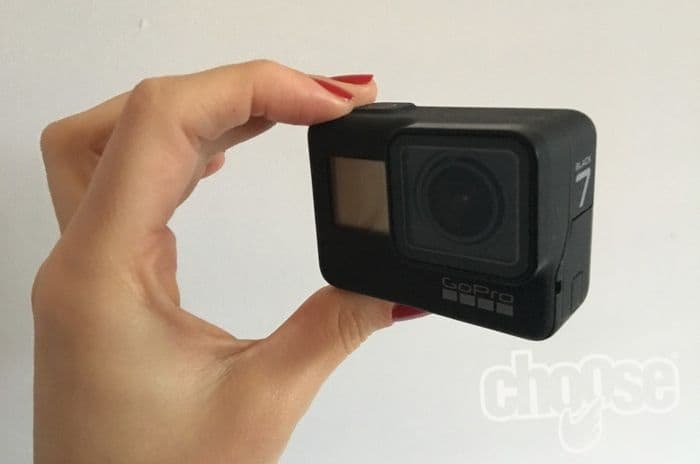
| Pros | Cons |
|---|---|
| Easy-to-use | Limited battery life |
| 4k video | Price (around £340) |
| Waterproof | Overheats when using 4k video |
| Compact design | |
| Image stabilisation |
Design
The Hero 7 is 6.2 x 4.4 x 3.2cm in size and weighs 118g; meaning its compact and lightweight and subsequently easy to carry around. In fact, we found it's even small enough to slip into a jacket pocket.
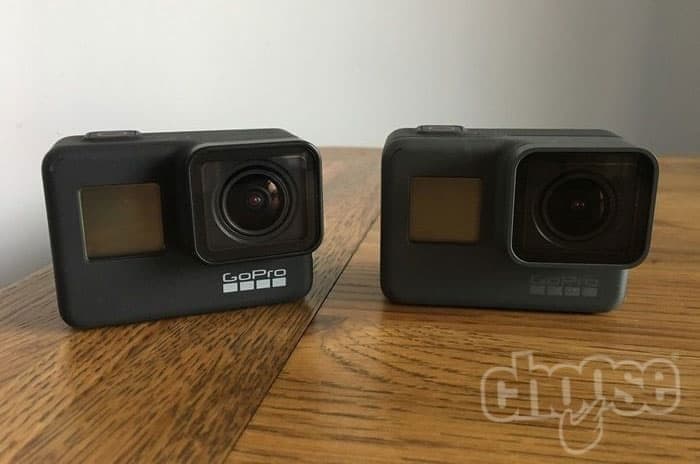
The Go Pro Hero 7 Black (left) next to the Go Pro Hero 5.
The plastic casing to the sides of the camera make it a little slippery to hold. The rubber casing that appears to the front of the device may have made for a more robust grip.
The camera features a 2-inch touchscreen that users can use to navigate between different settings. It worked well for the most part but there were a few occasions where the screen was either unresponsive or overly responsive and we'd ending up in the wrong setting as a result.
There is also a button on the right-hand side of the device that enables users to switch modes, from image, video or timelapse.
The same button can also be used to switch the device on and off. Rather than just tapping this button to switch the camera on or off, users will need to hold it down for several seconds. At first, we were just tapping the button and assumed the blank screen meant it had gone off yet a simple tap on the screen and the device would start up again. Thus we advise users to wait until they hear a few beeps, which indicate the device has been completely switched off.
The Hero 7 also has voice commands so users can activate the camera with simple phrases such as "Go Pro start recording" for hands-free control; perfectly suited to action users whose hands are otherwise engaged.
The Hero 7 Black is also waterproof up to 10 meters. Although we didn't test this aspect of the design here, the camera has received positive reviews elsewhere for its underwater photo quality.
Image and video quality
We shot the same footage at the same time of day using the Hero 7 and an iPhone 8 so that we could compare the quality recorded by the two devices. When it came to still images we found the two were evenly matched. Whilst the Hero 7 allowed us to capture a wider scene and produced a sharper image, the iPhone seemed to capture the light better when shooting daytime footage.

Daytime shot taken using the Hero 7 captures a wider scene and a sharper image.

Daytime shot taken using our iPhone 8. This image is quite blurry and captures a narrower scene than that captured by the Go Pro Hero 7, but it is brighter.
We shot the same scene several hours later around dusk time when the light was much darker. This time we found the Go Pro responded better, accurately capturing the light yet retaining the same high-quality detail.

The Go Pro Hero 7 did a good job capturing the same scene at dusk.
The quality of the image taken on the iPhone, on the other hand, seemed to struggle as the light dwindled. The light captured was much darker and the quality was some how compromised as the image appeared blurry.

Blurry image captured at dusk on the iPhone 8
The Hero 7's better ability to adapt to the change in setting may be due to the device's intuitive SuperPhoto feature that automatically adjusts the device's settings to suit the scene being shot. We didn't need to manually select the flash or make any other adjustments unlike we did with the iPhone.
On the whole though there isn't a big enough difference in the quality of images that would justify the expense of the Go Pro.
It's a different story when it comes to video though. The Hero 7 uses HyperSmooth image stabilisation technology, which Go Pro have touted as "the best in-camera video stabilisation on any camera, ever". This combined with the Hero's noise reduction and 4K resolution options results in a much better quality compared to the footage shot on the iPhone.
We walked the same path and then ran down the same hill using both devices and the difference in quality was quite remarkable. The video recorded on the iPhone was greatly affected by the movement, the footage was shaky and blurred and the audio was dominated by the sound of the wind.
The Hero's footage was by comparison much smoother and crisper and had a more balanced audio that benefited from reduced wind noise.
One thing to be wary of though is that the Go Pro overheated frequently when using 4k video. Typically after around 20 minutes the overheating would force the device to shut down.
The Go Pro Hero 7 vs. the Go Pro Hero 5
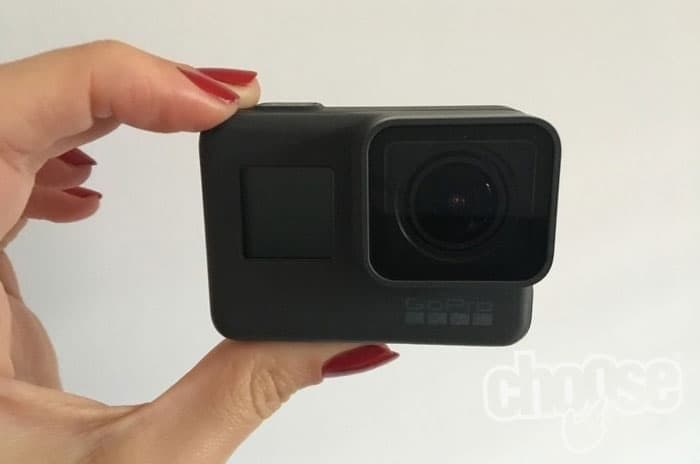
Go Pro Hero 5 Black.
Despite being released in 2016, the Go Pro Hero 5 Black is still a popular camera being widely sold by retailers for a lower price than the Hero 7. But is there a huge difference between the two models that justifies paying more for the Hero 7?
Apart from being slightly different shades of grey, the Hero 5 and 7 are almost identical looking cameras; they are similar in size, weight and shape, plus they include the same buttons and screen size.
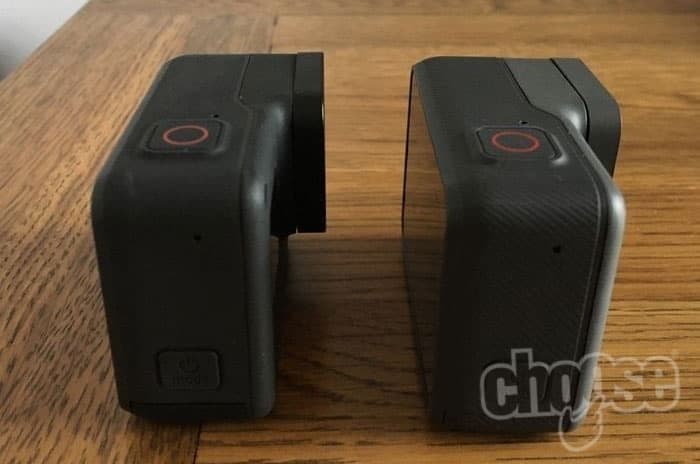
Go Pro Hero 7 Black and Go Pro Hero 5 Black have virtually the same design.
Like the Hero 7, the Hero 5 is also waterproof up to 10 meters.
Both cameras are controlled in the same way too; via the touchscreen and wirelessly through the Go Pro app. The touchscreen menu of the Hero 7 has been updated slightly but more in terms of looks than actual commands or settings. Both cameras also respond to voice commands.
The Hero 7 and 5 use the same 1200 mAh battery and thus offer the same battery life. We got a little more battery life out of the Hero 5 but we presume this was due to the fact that the lesser 4k video technology didn't drain the battery as much.
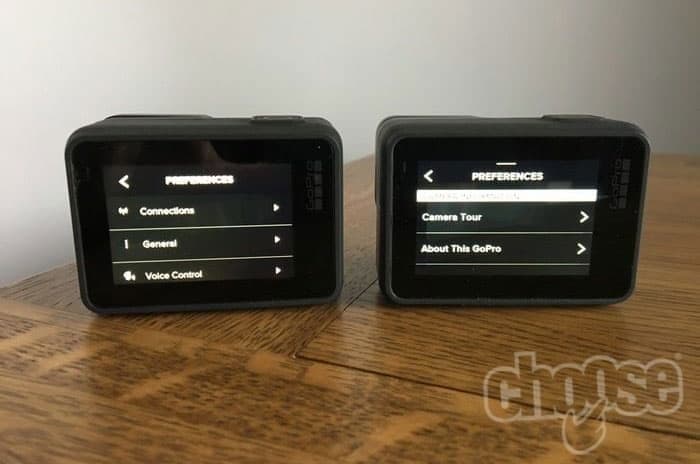
The camera display screen and menu has been given a slight revamp on the Hero 7.
So far the two seem pretty similar, but it's when we look at the more technical features that the crucial differences emerge.
While the Hero 5 shares many of the same features as the Hero 7, the latter benefits from a number of advancements. Chief among these are the better image stabilisation (HyperSmooth) and faster 4k video technology (4k 60 compared to 4k30. For us, this made the biggest difference between the two models. The Hero 5 was much more susceptible to shakes when we went for a jog with it and recorded a poorer quality than the Hero 7.
There's also a noteworthy difference in bitrates, which impacts video quality. The bitrates used by the two cameras vary depending on the setting being used, but the maximum bitrate of the Hero 7 and Hero 5 are 78Mb/s and 60Mb/s, respectively. We noted a difference in video quality even when using the same settings on both differences; the Hero 7 produced a sharper and better quality picture.
The Hero 5 also lacks SuperPhoto technology too, which means it doesn't always adjust its settings to reflect the conditions of the scene, which is a great advancement of the Hero 7.

The darker, lower quality image captured by the Go Pro Hero 5
Note the difference in brightness between the same scene on the Hero 7, in the above section, and the Hero 5 here.
However, the angle and quality of the image aren't too dissimilar to that of the Hero 7 and there's always the option to change photo settings to adjust to darker or lighter settings.
The Hero 5 doesn't offer a livestreaming option either, which may be off putting for some.
There is a timelapse option on the Hero 5. However, the quality of the video produced isn't as good as that produced by the timelapse setting on the Hero 7, which is again due to the lesser image stabilisation and 4k capabilities.
Additional features
TimeWarp
In the words of Go Pro this feature allows users to record a first-person "magic carpet ride". Essentially, it's a timelapse video feature that also benefits from HyperSmooth technology.
While timelapse videos usually work best when the camera is still and the action takes place around it, TimeWarp's smooth footage means it also works well when the camera is in motion like during a bike ride.
Go Pro's version of timelapse also allows users to determine exactly how slow they want the footage to be; they can set the factor by which the footage is slowed down.
Livestreaming
One of the biggest draws for bloggers is the Hero 7's livestreaming capabilities, which mean users can share footage on social media sites like Facebook as it's being filmed.
To work, this feature requires access to wi-fi or phone data and this is where things can get tricky. We attempted livestreaming at home using our wi-fi connection and had a smooth experience. When we took the Go Pro outside to film in a more remote setting, however, we found the connection, like our signal, was intermittent. This could create a big problem for those who wish to use the device to livestream countryside action, on hikes or bike rides for example.
The Go Pro app
Accessible to both iPhone and Android devices, the Go Pro app is free and easy to install; it took us less than two minutes to pair with our Hero 7.
Once installed, to access stored images and video, users will need to activate the Go Pro's wireless setting, which again takes just a few minutes.
Any new footage will appear automatically in the QuikStories section of the home screen once the devices are paired, making the uploading process super convenient. Indeed our footage transferred to the device within seconds.
The app can be used for way more than simply downloading content; users can add music, special effects and GPS stickers to their images and videos. In addition, they can set up a connection to their social media account and control their camera remotely via the app.
Battery life
Although Go Pro advise that it's possible to shoot around one and half hours of continuous video footage at 1080p/30fps, we only managed around 45 minutes. 4k video drained the battery even quicker. Although we didn't find this too restrictive for the short spells we took the camera out it may be a deal breaker for those who plan on shooting long action sequences.
Luckily, as the camera is charged via USB and only takes around an hour to recharge, users can carry a portable battery pack and top-up the energy supply during longer outings.
Go Pro Hero 7: Verdict
For keen action vloggers and the like we'd say the advanced image stabilisation technology, livestreaming capabilities and high quality 4k resolution do justify the cost. With the Hero 7 they'll get great quality footage that they can share with their followers in real time.
If it is a choice between the Hero 5 and Hero 7 we'd advise to opt for the latter again. While there aren't too many differences in terms of design, we'd say that more advanced image and video capabilities along side additional handy features like livestreaming and SuperPhoto mean the Hero 7 is the better option of the two. This is especially true when we consider that there isn't a great difference in terms of price; £248 for the Hero 5 and £340 for the Hero 7.
However, for more novice users looking to take pretty photos and some cool videos whilst out and about, their needs may be better served by a good quality smartphone camera. While keen photographers looking to capture the highest quality images may want to splash out on a fancier camera still.





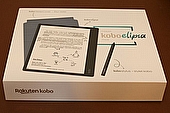

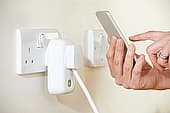

Comments